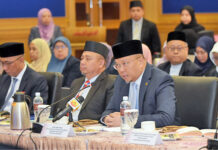Brunei Darussalam’s economic growth is projected to be 3.7 per cent this year and 2.8 per cent next year (2025), according to the Asian Development Outlook April 2024 released on Thursday by the Asian Development Bank (ADB).
The report was released a week after the ASEAN+3 Macroeconomic Research Office (AMRO) published its own annual flagship report, ASEAN+3 Regional Economic Outlook 2024 which forecasted Sultanate’s economic growth to be 2.7 per cent this year and 2.9 per cent in 2025.
The ADB report said Brunei’s growth will accelerate in 2024, partly due to a pickup that started in the second half of 2023.
A rebound in services underpinned the economic recovery over the last three years, but the outlook for the next two years depends on recovery in the oil and gas (O&G) sector.
Headline inflation has been subdued recently, but food prices remain high. Fiscal consolidation and revenue diversification are needed in the medium term to ensure fiscal equity.

The report said Brunei’s economy had robust growth in the fourth quarter of 2023. The long-subdued O&G continued to support growth. Despite signs of a sector recorded its first growth in the past three years, slowdown in consumption in supply-side data, private pushing gross domestic product (GDP) growth up by 6.8 per cent.
Meanwhile, growth in services, which has remained strong since the second half of 2022, somewhat slowed.
This is due to the normalisation in food and beverage services, which had exceptionally strong sales growth in the second half of 2022 and the first half of 2023.
On the demand side, Sultanate’s private consumption continued to support growth. Despite signs of a slowdown in consumption in supply-side data, private consumption on the demand-side grew by 4.8 per cent in the fourth quarter.
Fixed investment, by contrast, continued to decline. Weaker domestic demand dragged down imports by 8.3 per cent on weak machinery and transport equipment imports, contributing to GDP growth for the fourth consecutive quarter.
However, exports continued to decline for the fourth straight quarter, as exports of minerals, including O&G, fell compared to the same period last year.
Growth is forecast to accelerate to 3.7 per cent in 2024. Growth is expected to remain more robust than the historical trend as the economy continues to recover from the after- effects of COVID-19.
Previously deferred investment in the O&G sector will boost fixed investment over the forecast period. Supported by the replacement of production equipment and the opening of the Salman oilfield, daily oil production is expected to recover from 89,000 barrels per day to 95,000 barrels per day.
Liquefied natural gas production is expected to recover from 678 billion British thermal units (BTU) per day to more than 700 BTU per day. The recovery in O&G production will boost growth through higher exports. As production is expected to normalise in 2024, growth will moderate to 2.8 per cent in 2025.
The report also said economic diversification will continue under the Brunei Vision 2035 plan. The Sultanate’s long-standing efforts at economic diversification showed some progress in 2023.
In agricultural product exports, leveraging its reliable halal certification system, the country signed a trade facilitation agreement with Sabah, Malaysia for halal food products. Also, the country shipped its first local food exports to Singapore in September. Brunei is also investing to take advantage of its proximity to many offshore oil fields to become a ship dismantling and repair centre.
The demand for repair and disposal of related facilities in Southeast Asia is expected to grow in the coming years. Investment in the yard at Pulau Muara Besar through a public-private partnership began in 2022, with construction expected to be completed in 2025.
If successful, the integrated yard project is expected to bring more employment and income opportunities, the report stated.
That should help decrease the ratio of the O&G sector to GDP, which is currently around 50 per cent.
The growth outlook relies heavily on the recovery in O&G production. Risks are tilted to the downside. Limited private investment for maintenance and renewal in prior years may lower the operating rate of production facilities and, thus, future output in the O&G sector. The government recognises that rising geopolitical tension is a downside risk on growth and an upside risk for inflation as it may dampen oil prices via weaker global demand and increase production costs through supply chain disruptions.
Yet elevated international energy prices, if more persistent than currently expected, will be a tailwind for the country’s trade and fiscal balances over the forecast period. – Azlan Othman



















































